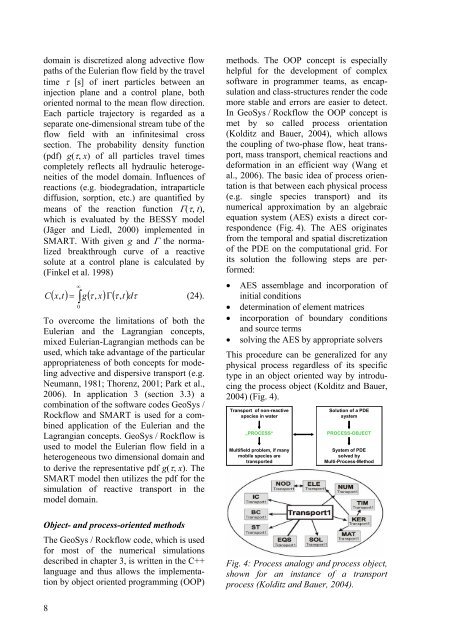Applied numerical modeling of saturated / unsaturated flow and ...
Applied numerical modeling of saturated / unsaturated flow and ...
Applied numerical modeling of saturated / unsaturated flow and ...
Create successful ePaper yourself
Turn your PDF publications into a flip-book with our unique Google optimized e-Paper software.
domain is discretized along advective <strong>flow</strong><br />
paths <strong>of</strong> the Eulerian <strong>flow</strong> field by the travel<br />
time � [s] <strong>of</strong> inert particles between an<br />
injection plane <strong>and</strong> a control plane, both<br />
oriented normal to the mean <strong>flow</strong> direction.<br />
Each particle trajectory is regarded as a<br />
separate one-dimensional stream tube <strong>of</strong> the<br />
<strong>flow</strong> field with an infinitesimal cross<br />
section. The probability density function<br />
(pdf) g(�, x) <strong>of</strong> all particles travel times<br />
completely reflects all hydraulic heterogeneities<br />
<strong>of</strong> the model domain. Influences <strong>of</strong><br />
reactions (e.g. biodegradation, intraparticle<br />
diffusion, sorption, etc.) are quantified by<br />
means <strong>of</strong> the reaction function �(�, t),<br />
which is evaluated by the BESSY model<br />
(Jäger <strong>and</strong> Liedl, 2000) implemented in<br />
SMART. With given g <strong>and</strong> � the normalized<br />
breakthrough curve <strong>of</strong> a reactive<br />
solute at a control plane is calculated by<br />
(Finkel et al. 1998)<br />
8<br />
�<br />
� �<br />
0<br />
�x, t�<br />
g��,<br />
x����t�d�<br />
C ,<br />
(24).<br />
To overcome the limitations <strong>of</strong> both the<br />
Eulerian <strong>and</strong> the Lagrangian concepts,<br />
mixed Eulerian-Lagrangian methods can be<br />
used, which take advantage <strong>of</strong> the particular<br />
appropriateness <strong>of</strong> both concepts for <strong>modeling</strong><br />
advective <strong>and</strong> dispersive transport (e.g.<br />
Neumann, 1981; Thorenz, 2001; Park et al.,<br />
2006). In application 3 (section 3.3) a<br />
combination <strong>of</strong> the s<strong>of</strong>tware codes GeoSys /<br />
Rock<strong>flow</strong> <strong>and</strong> SMART is used for a combined<br />
application <strong>of</strong> the Eulerian <strong>and</strong> the<br />
Lagrangian concepts. GeoSys / Rock<strong>flow</strong> is<br />
used to model the Eulerian <strong>flow</strong> field in a<br />
heterogeneous two dimensional domain <strong>and</strong><br />
to derive the representative pdf g(�, x). The<br />
SMART model then utilizes the pdf for the<br />
simulation <strong>of</strong> reactive transport in the<br />
model domain.<br />
Object- <strong>and</strong> process-oriented methods<br />
The GeoSys / Rock<strong>flow</strong> code, which is used<br />
for most <strong>of</strong> the <strong>numerical</strong> simulations<br />
described in chapter 3, is written in the C++<br />
language <strong>and</strong> thus allows the implementation<br />
by object oriented programming (OOP)<br />
methods. The OOP concept is especially<br />
helpful for the development <strong>of</strong> complex<br />
s<strong>of</strong>tware in programmer teams, as encapsulation<br />
<strong>and</strong> class-structures render the code<br />
more stable <strong>and</strong> errors are easier to detect.<br />
In GeoSys / Rock<strong>flow</strong> the OOP concept is<br />
met by so called process orientation<br />
(Kolditz <strong>and</strong> Bauer, 2004), which allows<br />
the coupling <strong>of</strong> two-phase <strong>flow</strong>, heat transport,<br />
mass transport, chemical reactions <strong>and</strong><br />
deformation in an efficient way (Wang et<br />
al., 2006). The basic idea <strong>of</strong> process orientation<br />
is that between each physical process<br />
(e.g. single species transport) <strong>and</strong> its<br />
<strong>numerical</strong> approximation by an algebraic<br />
equation system (AES) exists a direct correspondence<br />
(Fig. 4). The AES originates<br />
from the temporal <strong>and</strong> spatial discretization<br />
<strong>of</strong> the PDE on the computational grid. For<br />
its solution the following steps are performed:<br />
� AES assemblage <strong>and</strong> incorporation <strong>of</strong><br />
initial conditions<br />
� determination <strong>of</strong> element matrices<br />
� incorporation <strong>of</strong> boundary conditions<br />
<strong>and</strong> source terms<br />
� solving the AES by appropriate solvers<br />
This procedure can be generalized for any<br />
physical process regardless <strong>of</strong> its specific<br />
type in an object oriented way by introducing<br />
the process object (Kolditz <strong>and</strong> Bauer,<br />
2004) (Fig. 4).<br />
Transport <strong>of</strong> non-reactive<br />
species in water<br />
„PROCESS“<br />
Multifield problem, if many<br />
mobile species are<br />
transported<br />
Solution <strong>of</strong> a PDE<br />
system<br />
PROCESS-OBJECT<br />
System <strong>of</strong> PDE<br />
solved by<br />
Multi-Process-Method<br />
Fig. 4: Process analogy <strong>and</strong> process object,<br />
shown for an instance <strong>of</strong> a transport<br />
process (Kolditz <strong>and</strong> Bauer, 2004).

















